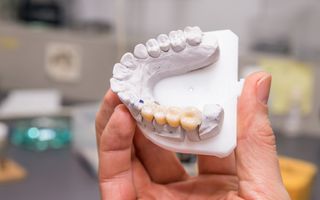
Are you missing one or more teeth? Is it affecting your ability to speak, eat, or smile with confidence? We understand the importance of a healthy and complete smile. Dental bridges are one of the options available for patients with missing teeth, and our friendly team of dental professionals can help you determine if a dental bridge is the right choice for you.
What is a dental bridge?
A dental bridge fills a gap between your teeth with false teeth, but without ‘implanting’ them into your jaw like a traditional dental implant. Instead, as the name suggests, a bridge connects a false tooth to your natural teeth on either side of the gap.
They can be a good option if you prefer not to have a dental implant, or if your gums or jaw are not in the right condition to receive an implant.
Bridges are usually made from metal, porcelain, zirconia (a very hard substance), or a mix of any of the three, and there are three types of dental bridges; traditional, cantilever, or the Maryland bridge.
A traditional bridge is the most common and involves placing dental crowns on the teeth on either side of the gap and attaching a ‘pontic’ (a false tooth) between them.
A cantilever bridge is less common. This is when there is only one tooth next to the gap, so the crown is placed over that tooth and the pontic is attached to it. It’s less sturdy than being attached at both sides, so is not a good option for back teeth that need to deal with a lot of pressure.
Finally, there is the Maryland bridge style, named on behalf of the University of Maryland where it was invented. This involves a similar concept to the traditional style by connecting a false tooth to the teeth on each side of the gap, but instead of using crowns for the attachment, it uses ‘wings’ that attach to the back of each tooth next to the gap. This is again not ideal for back teeth, and only really an option for those with good oral health.

How does a dental bridge work?
The exact procedure of your dental bridge may vary depending on the condition of your teeth and gums, and the type of bridge you get.
Typically, however, your dentist will start by doing an examination and x-ray and treat any gum disease or tooth decay before starting. The site and two abutment teeth must be in good condition to support the bridge.
Next, your dentist will prepare the abutment teeth. The dentist will remove a thin layer of enamel from each one to make space for the crowns, then make impressions of those teeth to send away to a lab. This lab will create custom-made crowns and a false tooth for your smile.
To finish this appointment, your dentist will add a temporary bridge. This will protect your teeth and gums and help you eat and drink normally until your permanent bridge is ready.
During your next appointment, your dentist will remove the temporary bridge and affix the permanent one in place with a special dental cement. They will shape the tooth to suit your bite and ensure you are comfortable with it.
The pros and cons of a dental bridge
A dental bridge is a great way to replace a missing tooth for several reasons:
- Avoids an implant: Dental implants are affixed to the bone below the gum line, and some people prefer not to do this procedure. Also, implants are not suitable for those with poor gum or jaw health.
- A full smile and confidence: Missing teeth can lead to less confidence, with some people preferring to smile with their mouths closed to avoid showing the gap. A bridge fills this gap with a natural-looking tooth.
- Normal functionality: A dental bridge offers full functionality, meaning you’ll be able to eat, drink, and talk normally.
- Better oral health: A missing tooth can cause faster deterioration in your other teeth, and tooth movement for the remaining teeth, which means a bridge can improve your dental health.
There are also some other considerations for bridges when compared to other options for replacing teeth.
- Traditional bridges sometimes require putting crowns over perfectly healthy teeth: The adjacent teeth that support the bridge will require reshaping and covering, leading to the removal of a portion of their healthy tooth enamel. This heightens the potential for enduring harm to teeth that were initially in good condition. If the adjacent teeth already have fillings, crowns may benefit them.
- Maryland bridges can cause damage to the existing teeth and are not as sturdy: Maryland bridges can cause permanent damage to healthy teeth due to the cementing of metal at the back of the teeth. Additionally, these bridges are less resistant to chewing pressure compared to other types of bridges.
- Bridges don't correct bone loss in the jaw: When a tooth is absent or removed, the jaw bone that previously supported it initiates a process of resorption or dissolution. Unlike implants, which feature an artificial root anchored into the jaw bone, bridges are positioned above the gum line and lack roots. Consequently, bridges do not prevent bone loss like implants do.
- Bridges may not last as long as implants: The success of the bridge depends on the health and strength of the teeth it’s placed on. If decay occurs under the bridge, if there are gum problems, the bridge can fail.
How much does a dental bridge cost?
This cost varies depending on the type of bridge you get, the materials involved, and other factors. Your dentist will be able to give you a better estimate once they have a better idea of your situation and oral health.
Keep in mind, that your insurance may pay for some of the treatment, so it’s worth checking with your provider.
Ready to restore your smile? Regain functionality with a dental bridge and take the first step towards a restored smile. Get in touch with our friendly team to schedule an appointment.
Frequently asked questions
With good care and regular check-ups, a dental bridge can last for at least 10 years. You will need to avoid biting down on very hard and very sticky foods to minimise the chance of breaking the bridge or even pulling it off.
You will also need to maintain good dental hygiene to support the strength of your natural teeth and gums, as these support the bridge.
Usually, a bridge replaces just one tooth, but it can replace up to four teeth. It can depend on your oral health and the placement of the gap, so be sure to ask your dentist for the best options.
Dental bridges are quite safe with few side effects, but there are some possibilities to be aware of. These include swelling and pain around the site following each procedure, infection, potential nerve damage, and breakages or slips of the bridge itself.
If you experience any side effects following your dental bridge treatment, don’t hesitate to contact your dentist.

